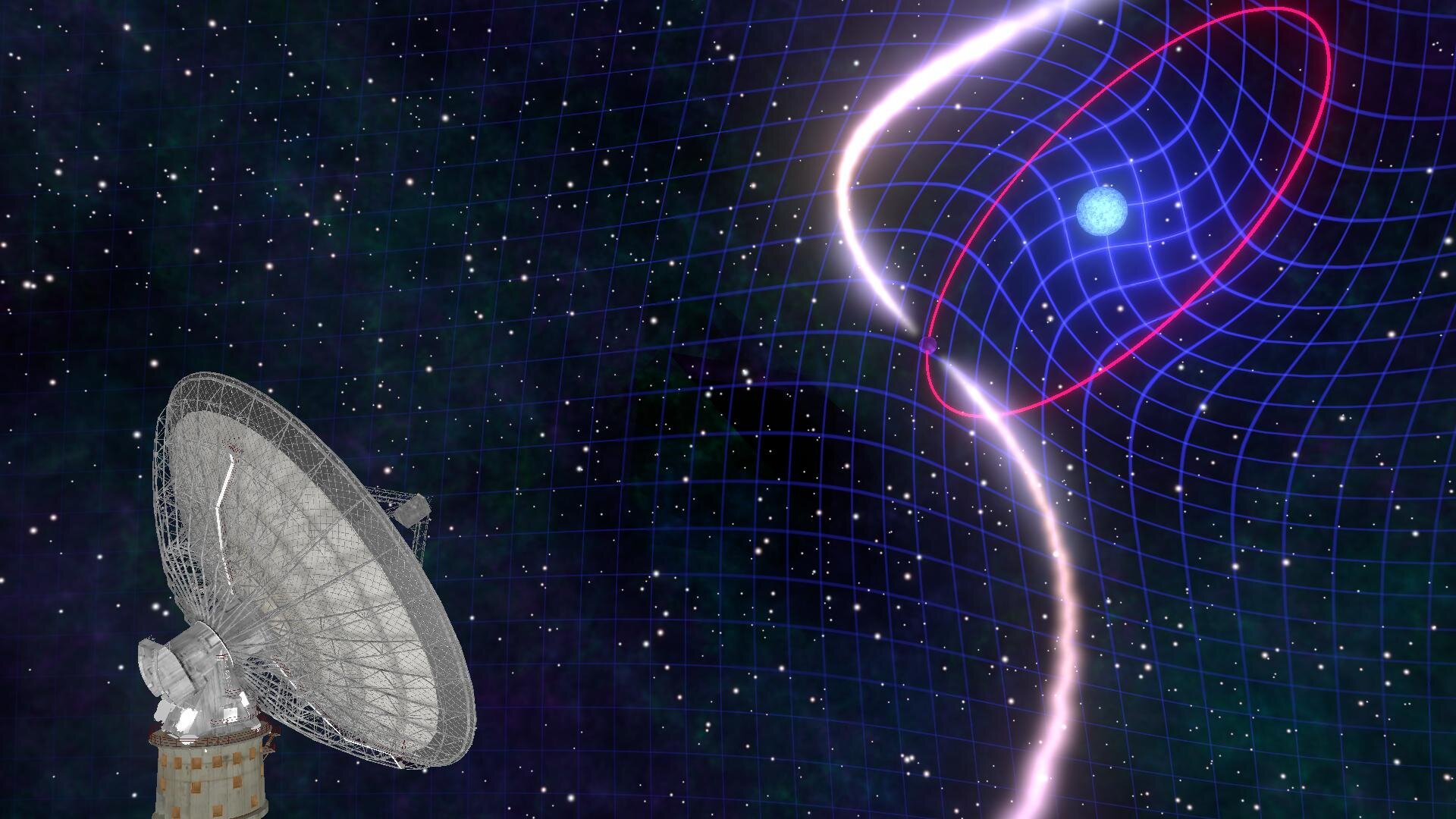 'Frame-dragging' with two spinning stars twisting space and time. Credit: Mark Myers, OzGrav ARC Centre of Excellence.
'Frame-dragging' with two spinning stars twisting space and time. Credit: Mark Myers, OzGrav ARC Centre of Excellence.
(Swinburne University of Technology) An international team of astrophysicists led by Australian Professor Matthew Bailes, from the ARC Centre of Excellence of Gravitational Wave Discovery (OzGrav), has shown exciting new evidence for 'frame-dragging'—how the spinning of a celestial body twists space and time—after tracking the orbit of an exotic stellar pair for almost two decades. The data, which is further evidence for Einstein's theory of General Relativity, is published today the journal Science.
The unusual star system known as PSR J1141-6545 was discovered around 10,000 light years away in the constellation of Musca aka The Fly in 2001. Since 2001 we have trekked to Parkes several times a year to map this system's orbit, which exhibits a multitude of Einsteinian gravitational effects.
At the heart is a fast-spinning white dwarf star — the remains of an old star about the size of Earth but 300,000 times its density.
Every five hours it is circled by a neutron star (pulsar) — the core of an exploded star no bigger than a city but about 100 billion times more dense than Earth.
The neutron star sends out regular pulses of high-energy particles like a lighthouse, which the astronomers used to track its orbit.
Mapping the evolution of orbits is not for the impatient, but our measurements are ridiculously precise. Although PSR J1141-6545 is several hundred quadrillion kilometres away (a quadrillion is a million billion), we know the pulsar rotates 2.5387230404 times per second, and that its orbit is tumbling in space.
This means the plane of its orbit is not fixed, but instead is slowly rotating.
Lead author Vivek Venkatraman Krishnan, Max Planck Institute for Radio Astronomy (MPIfR): "At first, the stellar pair appeared to exhibit many of the classic effects that Einstein's theory predicted. We then noticed a gradual change in the orientation of the plane of the orbit."
"Pulsars are cosmic clocks. Their high rotational stability means that any deviation to the expected arrival time of its pulses is probably due to the pulsar's motion or due to the electrons and magnetic fields that the pulses encounter. Pulsar timing is a powerful technique where we use atomic clocks at radio telescopes to estimate the arrival time of the pulses from the pulsar to very high precision. The motion of the pulsar in its orbit modulates the arrival time, thereby enabling its measurement."
YouTube video: Dragging the Space-Time Continuum by OzGrav ARC Centre of Excellence:
Dr. Paulo Freire: "We postulated that this might be, at least in-part, due to the so-called 'frame-dragging' that all matter is subject to in the presence of a rotating body as predicted by the Austrian mathematicians Lense and Thirring in 1918."
Professor Thomas Tauris, Aarhus University: "In a stellar pair, the first star to collapse is often rapidly rotating due to subsequent mass transfer from its companion. Tauris's simulations helped quantify the magnitude of the white dwarf's spin. In this system the entire orbit is being dragged around by the white dwarf's spin, which is misaligned with the orbit."
References
https://phys.org/news/2020-01-astronomers-witness-space-time-stellar-cosmic.html
https://www.abc.net.au/news/science/2020-01-31/space-warping-star-system-proves-einstein-was-right-astrophysics/11903018
https://www.sciencealert.com/scientists-caught-a-star-in-the-act-of-warping-the-fabric-of-space-and-time
https://www.scientificamerican.com/article/bizarre-cosmic-dance-offers-fresh-test-for-general-relativity/
